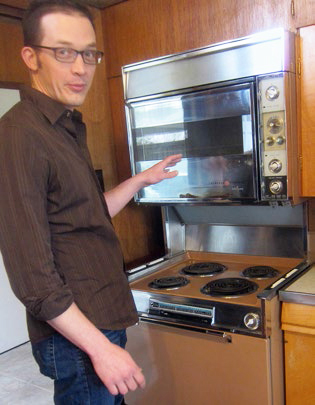Morepark on the Move - Page 4
 |
 |
 |
|
|
The home of Jessica Endlich and Mark Winkler is almost entirely original—including the oven. Only problem is—the oven and half the stovetop don't work. Mark has been looking for replacement parts and a repairman who's into historical devices.
His wife has her doubts. "We love cooking," Jessica says, "and it's not conducive to that in any way."
Mark and Jessica go back and forth on the issue of preserving original materials. "When you first moved in," Jessica reminds Mark, "you said you wanted to get rid of the wood."
"It was dark," Mark replies. "I thought the problem was with the walls. Now I think it's a problem with the lighting."
Elyse and Dan, whose house is largely original, have wrestled with the same issues.
"You always have the question, do you change it?" Elyse says. "We're always asking each other. We all know it means something if you change it. If you change it, you're really doing something so major. It's so special after 50, 60 years."
Back then the neighborhood was much as it is today, says John Carter, who moved in with his wife circa 1960. A Pennsylvanian who'd been working in Connecticut, he'd never heard of Joe Eichler when a friend suggested he visit a home for sale.
"It was the first Eichler I'd ever seen," Carter says. "I'd never owned a home. To see an Eichler for the first time, you could not help but be carried away, regardless of what condition it was in. To own your own house! It was small and compact."
It was a friendly neighborhood, with people knowing many of their neighbors on the street.
Carter, 93, didn't attend neighborhood parties, socializing most with his colleagues in the world of social work. Over the years he'd direct county social service divisions, run a marriage and family practice, and teach at San Francisco State and UC Berkeley.
There were a few other black people in the tract. Some neighbors taught at San Jose City College and at other schools.
Carter played a role in the neighborhood as a timekeeper and delivery boy.
"I was into physical fitness," says Carter, who played golf until recent years. "When the sun came up I was on the track at San Jose City College every day. People could tell what time it was by seeing John Carter come out of his house."
If people's papers were out and it looked like it might rain, he'd toss them beneath the front overhang. "I was out every day, even in the rain," he says, adding, "Very few people in the neighborhood were into physical fitness."
On the whole, Carter says, the minority owners had no problems—but he does remember this.
"I remember when I was working in the front [of my home] putting in a lawn. Some neighbors came and looked over the hedge. They were saying things like, 'We take care of our property here.' I ignored them, because I knew about taking care of property. My father owned a house.




